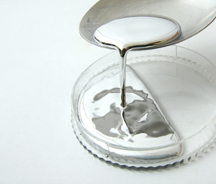Part II – Gold Rush: What is Mercury?
 Having taken a look at Gold Rush era mercury use and its modern consequences in our last blog it only seems logical to discuss what mercury is and why it poses such great human health risks. Because mercury and its associated risks is a broad topic, part three of our series on mercury will only look at mercury’s most well known forms.
Having taken a look at Gold Rush era mercury use and its modern consequences in our last blog it only seems logical to discuss what mercury is and why it poses such great human health risks. Because mercury and its associated risks is a broad topic, part three of our series on mercury will only look at mercury’s most well known forms.
About Mercury
Mercury (Hg) is a naturally occurring element that exists in three general forms:
- Elemental Mercury - The pure form of mercury uncombined with other elements and commonly known as the shiny liquid metal used in thermometers and electric switches.
- Inorganic Mercury Compounds - Forms of mercury that have combined with other elements such as chlorine, sulfur or oxygen, and are known as “mercury salts.”
- Organic Mercury Compounds - Any form of mercury that has combined with carbon. There are numerous examples, but the most commonly cited, and among the most toxic, is methyl mercury. Like inorganic mercury compounds, organic mercury compounds exist as salts (combining with chlorine for example).[i]
Mercury is found in air, water, soil, rocks and coal, and cannot be created or destroyed (although it can change forms).[ii] Mercury occurs in the environment naturally and is found as metallic mercury, mercuric sulfide (cinnabar ore), mercuric chloride, and methylmercury (generated by microorganisms and natural processes[iii].
Mercury’s Forms
As mercury cycles and is recycled in the environment it can be transformed into different forms of varying toxicity. Geochemical and ecological factors influence how mercury is transported and affect its ability to change from one form to another[iv]. This cycle consists of six major steps:
- Degassing of elemental mercury vapor from rock, soils, and surface waters or mercury emissions from natural and made-made activities.
- Globally transported via the atmosphere
- Settling on land and water
- Conversion into insoluble mercury sulfide
- Optionally falling to the earth in the form of precipitation or conversion into more toxic forms such as methyl mercury
- Recycled back into the atmosphere or entering the food chain where it accumulates[v]
Because various types of mercury have differing levels of toxicity the human body responds to mercury exposure differently according to the form and means of exposure. Exposure to mercury continually exists through air, water, and food, although the amount is miniscule enough to be deemed harmless[vi].
In part three of our Mercury blog series, we will dive into the well-known forms of mercury.
Teledyne Leeman Labs Mercury analyzers are used to test soil and water for mercury contamination. For more information on these analyzers, visit http://www.teledyneleemanlabs.com/products/mercury/index.asp
[i] Agency for Toxic Substances and Disease Registry (ATSDR)., http://www.atsdr.cdc.gov/substances/toxsubstance.asp?toxid=24
[ii] U.S. Environmental Protection Agency. http://www.epa.gov/hg/about.htm
[iii] Agency for Toxic Substances and Disease Registry (ATSDR), http://www.atsdr.cdc.gov/substances/toxsubstance.asp?toxid=24
[iv] Mercury in the Environment; Publications - Fact Sheet 146-00 October 2000. U.S. Geological Survey. http://www.usgs.gov/themes/factsheet/146-00/
[v] University of Wisconsin-Eau Claire - People Pages. Mercury in the Environment and Water Supply.
[vi] Agency for Toxic Substances and Disease Registry (ATSDR)., http://www.atsdr.cdc.gov/substances/toxsubstance.asp?toxid=24

